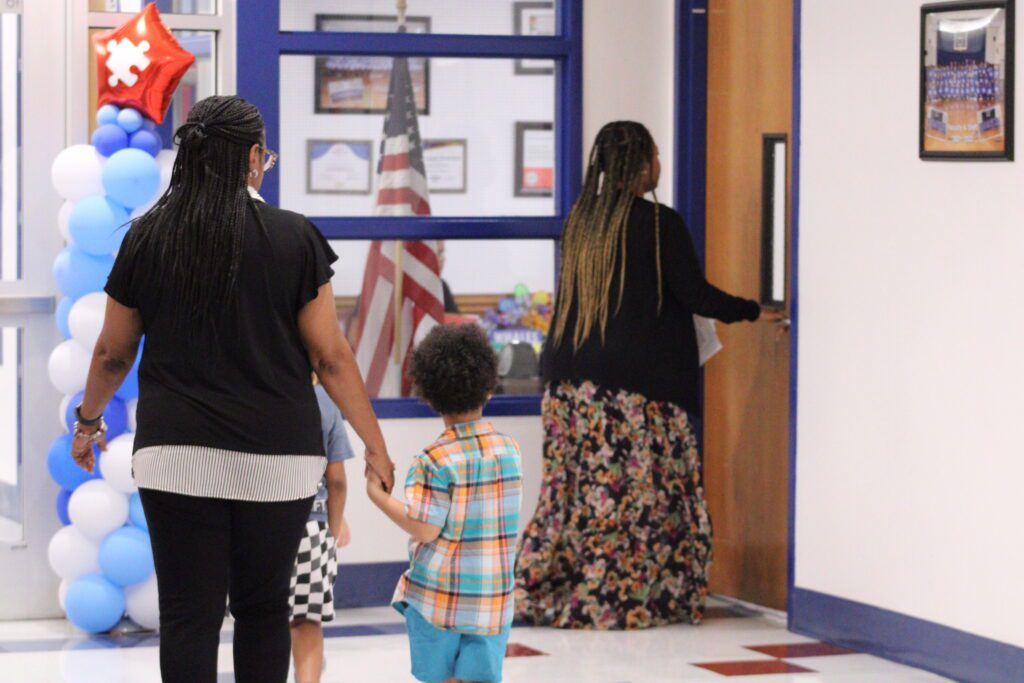Share this story
The first day of school was driven by change and belonging in Durham County.
Durham Public Schools welcomed back their year-round students on Monday. This year, four additional schools — Eastway, Hope Valley, Oak Grove, and W.G. Pearson elementary schools — will operate on the year-round calendar “to accommodate a growing demand,” the district announced. As part of DPS’s Growing Together initiative, this change makes year-round options available in each of the school district’s five regions.
Rita Rathbone, district magnet specialist, said Durham Public Schools is excited to make year-round schools accessible to more families.
“Many families love the year-round calendar because it provides more balance for students and families with frequent breaks for students to rest and recharge, expanded learning opportunities for those that need more support or enrichment, and more quality family time throughout the year,” Rathbone said in a press release. “Both research and family experience demonstrate potential benefits for student’s academic, emotional, and physical health from the year-round calendar.”
Holt, Easley, and Pearsontown elementary schools, along with Rogers-Herr Middle School and The School for Creative Studies, currently operate on year-round schedules.
When a school operates on a year-round calendar, they have nine-week sessions followed by breaks that last about three weeks. They also have a roughly five-week summer break.
According to the district, Growing Together also includes elementary dual-language immersion programs in each of the five regions, along with the provision of STEM by Design instruction daily in every elementary school and district-wide accessibility to Montessori and International Baccalaureate (IB) programs.
The implementation of the plans puts no sweat on one principal’s forehead.
“It’s the first day of school, and it’s 9 o’clock, and everybody who’s supposed to be here is in class,”Asia Cunningham, principal of Pearsontown Elementary, said.

Cunningham, a historic Milken Award recipient, said that Pearsontown has a legacy of excellence. She welcomes the new families that are choosing their school as a result of the new base school boundaries.
“We don’t care where the students come from. By design, our goal is to make sure when they leave here is an experience that they never forget. And that’s just a legacy of all the principals that have led this building to make sure that we take care of every kid,” Cunningham said.
DPS has 55 schools and more than 2,400 teachers serving nearly 31,000 students. Starting Aug. 12, Dr. Anthony Lewis will begin a four-year term as superintendent.
You can see more facts about the district below.

For the first time in 30 years, the district redrew their boundary lines. The lines determine what schools students are assigned to based on their address. According to the district’s website, the new boundaries were created using historic student enrollment, residential development and growth in Durham, and median family income data.
Per the district documents, they believe the rezoning will increase diversity, equity, and inclusion.
“Moreover, regions were designed to ensure that each region has at least 50% families of color (self-reported in the 2019 American Community Survey) and at or above $50,000 median family income. In addition, application programs were placed and assigned neighborhood enrollment boundaries to promote access to academic programs that would be beneficial for all students,” district documents said.
Tiffany Wagstaff, a veteran kindergarten teacher at Pearsontown, said she is excited for the district to begin “growing together.”

“I’m excited to see the different backgrounds that everyone is coming from,” Wagstaff said. “… and how we all can come together and be diverse, and make sure (students are) engaged in the curriculum and teaching them and teaching them something new that they haven’t learned.”
Wagstaff has taught kindergarten for five years and has been a part of Pearsontown for eight. She said that she would encourage other educators to have an open mind.
“Inclusion is important. Engagement, and parent involvement. And just creating that diverse classroom. Whatever problems that you may have at home, it’s hard sometimes to leave it at home,” Wagstaff said. “But you know, you just have to come in to work, with especially young students, with a smile on your face, joy in your heart, and be ready to teach these kids and get them engaged and excited about learning.”

Pearsontown Elementary’s theme this year is “Together is better.” Whether that means bringing food trucks for a school open house, or holding a retreat for teachers, the theme ties in, Cunningham said.
According to the district, a part of the new initiative is to provide every elementary school with daily classes in STEM (science, sechnology, engineering, and mathematics) and weekly visual arts, music, and global languages experiences.
Cunningham said Pearsontown began the process of incorporating these things a couple of years ago. She said they incorporated a solid classroom strategy using the Eureka math homework program. Their Spanish program is also growing. And to top it off, they have a STEM camp planned for intersessions — the break after their nine week sessions — where students can do things like code robots to perform different tasks.

“With that being in place, we see already innovative practices and programs that are being built for our students around mathematics. So for us, we really wanted to tap into kids being innovative and being able to create and design,” Cunningham said.
Durham is growing, and in Cunningham’s eyes, there is always a way to connect with resources to help students be successful.
“Durham is hard work. You don’t just say yes to Durham because you want a teaching job,” Cunningham said. “You say yes to Durham because you are truly in a space where you want to make a difference in the lives of children.”





